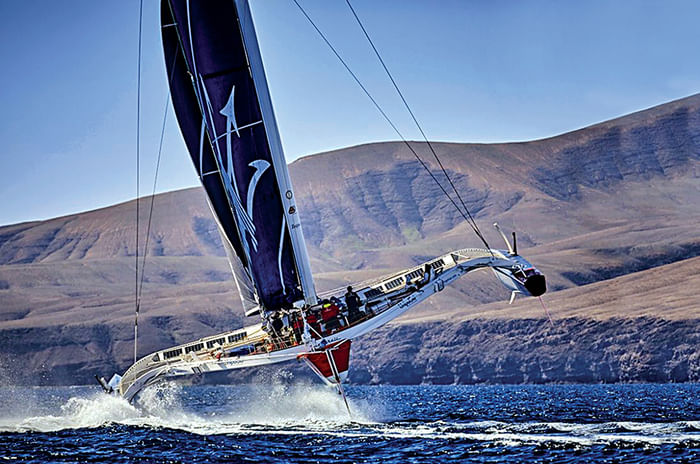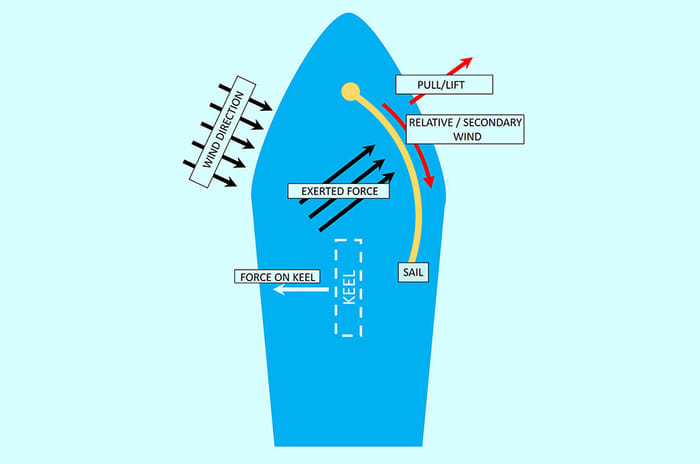The smell of the ocean, the salty breeze and sunlight glinting off the wave tops... sounds like I’m on a vacation in Goa, right? But no, I was staring out at the cool blue Mediterranean, ready to experience a Maserati – yes, a Maserati – out at sea!
Meet the Maserati Multi 70 (multihull, 70ft) – a MOD70 class, ocean-going trimaran (three hulls) that flies across open waters at over 40 knots, or 74kph in land terms. And by flies, I mean it quite literally; at speed, the hulls rise out of the water and the yacht sails on the foils and rudder alone, thus reducing the submerged surface area and increasing speed. And speed is something that the Mutli70 has put to good use, winning quite a few races like the RORC Transatlantic race and setting records like the Tea Route record from Hong Kong to London with a time of 36 days, 2 hours, 37 minutes and 12 seconds.

I’m at the Cannes Yacht festival, and while the opportunity to experience another form of transport is thrilling, I’m also absolutely terrified; I come from a family of sailors and love the ocean, but I don’t really have strong sea legs. Making matters worse is the fact that this is no leisure boat; this is a lean mean racing machine, in every sense of the phrase. There are no lounges – heck, there’s not even a proper deck – just a lot of net spanning the gaps between the hulls, and forget rolling, this one rolls, pitches, tilts and flies too. Watching YouTube videos of it rising completely out of the water, looking like it’s about to tip over didn’t really help; tip over they do, it’s something everyone has experienced in the racing world.

Mercifully, Maserati has planned a short and relaxed 2hr sail, but skipper Giovanni Soldini has other plans. He tells me he’s hoping to show us full flight mode, but doesn’t think it’ll be possible as wind speeds aren’t good this morning; he doubts we’ll even cross 20 knots, but promises to try his best. Should I tell him I’m actually quite relieved? I decide against it, as this is a rare opportunity, and I’ve tanked up on ginger (Travel tip: to avoid motion sickness stay away from sweet stuff, suck on a lime wedge or ginger; it helps keep things down). Also, with Soldini’s track record, I’m sure I’m in good hands.
The Maserati Multi 70 is anchored out in the bay, so we take a short ride out to it in a powered inflatable. It looks magnificent with its main sail unfurled and standing tall. Once aboard, the crew gives us a quick tour of the vessel as we sail out of the bay. There’s not much: lots of net they say we can safely walk over, an area inside the main hull that is as small as a study but here it holds a work desk, navigation equipment, sleeping bunks, provision storage, and a kitchen too. Below that is the engine room; yes, this is a sailing ship but it has a small motor that’s used mainly to manoeuvre inside the harbour.

It’s hard to imagine living in such cramped quarters. Space and weight (this is a racing boat) are kept tight. There is, of course, carbon fibre used in the construction, but everything is in small measure. The sea-water distiller is of small capacity, the sleeping mattresses are thin and light, and provisions are meagre – they don’t even carry salt; they cook in sea water. Soldini, however, is quick to point out that’s only when they’re far away from shore.
As soon as we’re out of the bay, the crew kills the engine and turns the sails into the wind. As predicted, the winds are not very strong, so we’re moving along at a gentle 10-12 knots. Being driven along purely by nature’s force feels so pure. All you can hear is the sound of the wind and all you feel the breeze on your face; there’s no engine or motor sound, and there’s no manual labour to be done. Well, for the passengers at least, the crew does a lot of hard work as I soon find out.
I ask Soldini if I can man the rudder for a while, explaining that I’ve sailed in a friend’s small two-seater Laser craft, and that I come from a family of merchant navy sailors. He’s not impressed at all, but he lets me sit at the rudder with strict instructions to do absolutely nothing. And I don’t; I’ve seen how these things tip over, and the last thing I want is to be known as that guy who wrecked a million-dollar Maserati.

Even then, just sitting there on the edge, with my hand at the rudder, was amazing. Seeing that I’m really enjoying this, the crew asks me if I’d like to try trimming the sail – that means correcting the sail’s position in the wind. I know it’s hard work; you have to pedal away at the ‘grinder’, and it has to be done furiously fast. So, I really put my back into it, grinding away at the pedals with both hands; I’m going as fast as I can, hands flying around the whole time, and after a minute of non-stop action, I look up to gauge my progress – everything looks the same. And it is; it needs a lot more effort. One of the crew joins in, standing opposite me explaining that they do it in tandem at times. No sooner does he start though, my hands flail about so fast that I’m pretty sure my shoulders would pop, so I quickly let go.

In any case, Captain Soldini says the wind has picked up and he thinks we can get a little past 20 knots. So the pros get to it, trimming the sails and we soon pick up speed. We now have one side hull and the main hull out of the water, and we’re flying along on the foils and one hull in the water at 22 knots. It’s an awesome feeling but it isn’t as smooth as you’d imagine, with the boat slapping back and crashing into the small waves with quite a thud. I hold on tight, but judging by the relaxed stance of the crew – Soldini is even eating a sandwich while at the rudder – I know things get a lot wilder at higher speeds. It’s still exciting for me, though.

We glide along like this for a while, the sound of the breeze now quite a loud buffeting, and every now and then being refreshed by small salty sprays that kick up onto our faces. I could do this for hours, but we soon turn around and head back. It’s slower now, however, and I’m glad as I really don’t want this to get over. Soldini hopes we’ve had a good time, which I assure him we have and thank him. He wishes us a safe flight back and enquires about our flight time. I tell him when I’m headed out and ask what time he’s expected to fly back to Italy. He looks at me with a huge smile on his face, turns to his boat and simply says, “Whatever time the wind’s ready”.
Against the wind
If you don’t think about it, sailing seems simple enough. Just hoist a sail, let the wind blow into it and you’ll go forward. True, but how do you sail against the wind? And how do boats actually manage to be faster than the speed of the wind?

When sailing against the wind, the trick is to not go directly against it but at an angle where the breeze blows into the sail, curving it. And since the sail is held taut, the shape makes the wind change its direction resulting in an opposite force on the sail (Newton’s third law), thus pushing the boat forward, at an angle, of course. Countering that are the fins or keel below the hull; it helps correct this force and gives the boat a straighter direction. Then it’s down to the sailor to zig-zag their way to where they want to go.
Sailing against the wind is also where boats can go faster than the wind speed itself. While the boat is moving forward, a second wind is also felt on the outside of the sail,. This relative wind (what you feel as you go faster on a bike) curves around the outside edge of the sail generating lift, just like a wing of an aircraft. With the sail perpendicular, this lift acts a pull that helps drag the boat forward.
Giovanni Soldini

Soldini is one experienced, hardened, weather-beaten sailor. But he’s also a through gentleman and very generous. In my conversation with him, I learn he’s concerned about the migrant scenario in Europe and the destruction of the environment. He surprises me by saying he knows of our government’s decision to ban plastic and is very impressed by the move.
In the sailing world, he’s a rockstar, winning races like the English Transat – a solo transatlantic race and the Around Alone, another solo around-the-world race, where he came first, while also diverting to rescue French competitor Isabelle Autissier, whose boat capsized. That “normal step that anyone else would also do” (his words) also earned him the National Order of the Legion of Honor, the highest French honorary decoration for those rendering ‘eminent services’ to France. I ask him if he thought of just carrying on with the race and letting the rescue boats handle it. “Not at all.” It’s the code of the sea, and even if he had lost the race, he wouldn’t have regretted it. The only regret he had was, “She finished all my wine.”




























